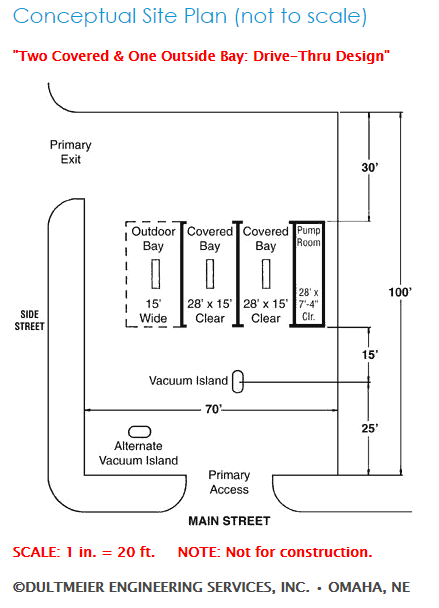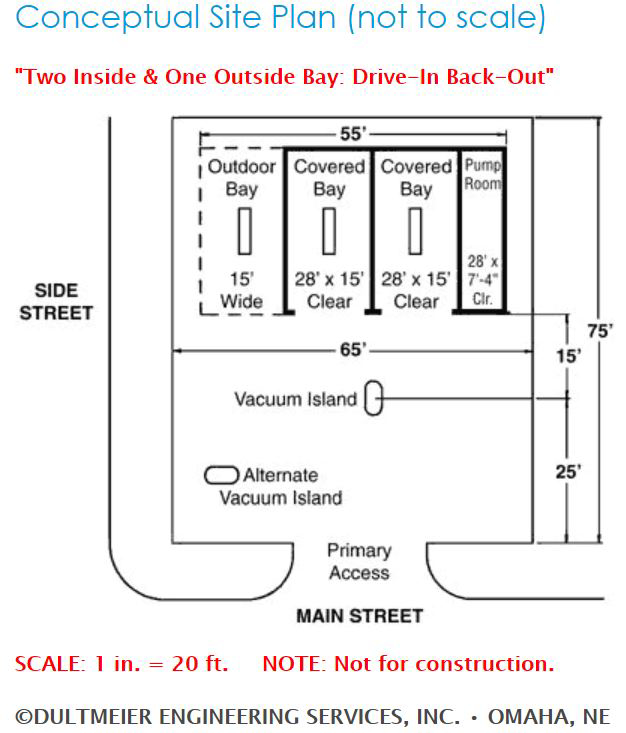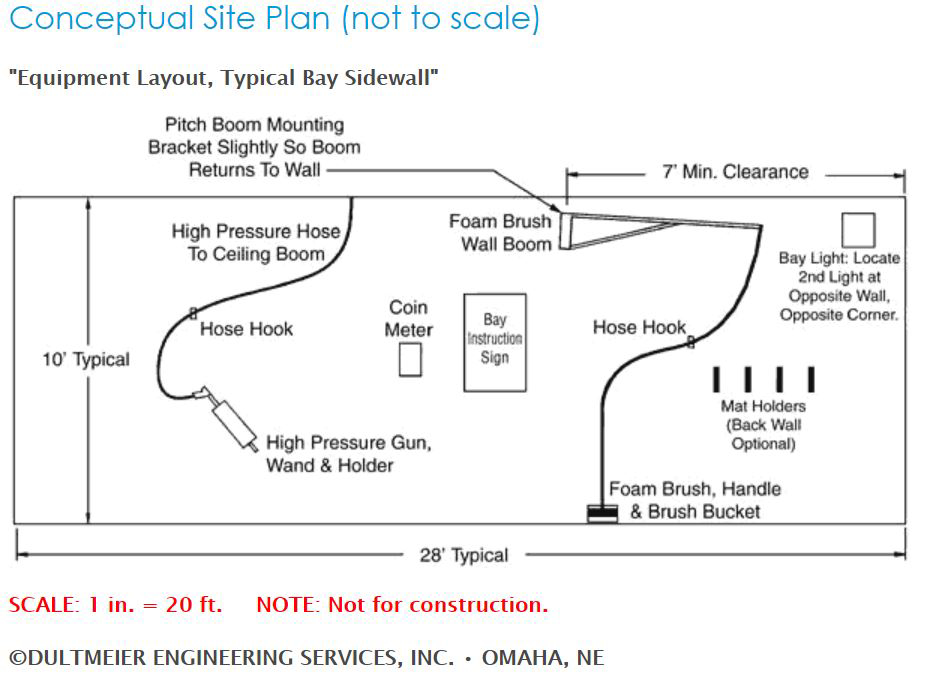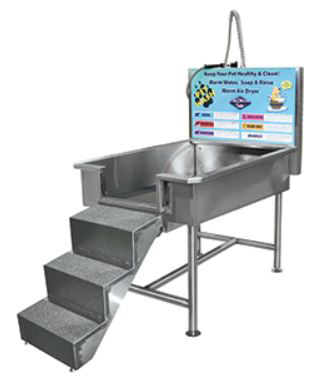Have you been pondering the idea of starting a car wash? Does the idea of passive income sound appealing? That's because it is. Do know that there is an extensive amount of upfront work and then there is the issue of ongoing maintenance. That being said, once you have an operational car wash up and running - you can consider it passive income.
Everything You Need to Know About Starting a Car Wash Business
The information below is a compilation of countless periodicals, customer surveys, and testimonials. At any point in the process of your new adventure, should you feel the need to ask about something in more detail don't ever hesitate to contact us. Let's dig into what you will need to do in order to properly align yourself to start a car wash.
Car Wash Lot Selection
A general rule to follow when sizing lot is that you will need a lot approximately 100 - 120 feet deep by a minimum of 75 feet wide - depending on the number of bays. Keep in mind a typical four bay self-serve car wash would need a lot 120 feet long by 100 feet wide - minimum. Another key attribute when selecting the ideal lot for your car wash is that it is accessible from both directions of traffic flow.
For instance, if you select a lot that is on a one-way street it will negatively affect the volume your wash is capable of producing. The ideal traffic speed in the area of your lot selection should be around 40 miles per hour. This ensures that drivers have ample time to select your wash as their destination. The lot size and shape will determine if you design a "drive-in-back-out" or "drive-through" building.
Data shows that income streams do favor the "drive-through" design. Lastly, when selecting your ideal location it is a good idea to target areas near residential neighborhoods, apartment complexes, or busy traffic routes. When determining if your ideal lot selection is a good fit for your business plan, you should consider the finances, as well.
A safe rule to adhere to is that the cost of the property (monthly lease payment) should not exceed 15 - 20% of the gross monthly income of the wash. This ensures that you will not over-extend yourself, financially.

Bay & Building Sizing
An ideal bay is 16 feet wide by 28 feet long - these are the interior wall measurements. If you are planning a semi-truck bay make sure to account for internal wall measurements of 18 feet wide by 28 feet long. You can make a smaller bay work for trucks but why not just do it right from the start? The typical pump (equipment) room is 10 - 15 feet wide by 28 feet long (internal measurements).
Furthermore, the typical bay height is 10 feet high for cars and 12 - 14 feet high for semi-trucks. Your lot size above will vary depending on what your overall wash purpose is (car vs. semi-truck) and the number of bays you intend to have. That's why we recommend determining the bay purpose and number of bays at the same time you are selecting your ideal lot location.
Building Placement
It's always best practice to consult local regulatory agencies to ensure your building is within code. That being said, your building should be situated on the lot to allow for one to two cars, minimum, to be parked behind each bay, waiting to wash. Vacuums should be placed in this area, as well, but should not be an impediment to the normal traffic flow into the bays. Another important concept to consider is that you ensure there are adequate drying and vacuuming areas.
These areas should be out of the main traffic flow to avoid congestion. It is a good idea to allow for a southern exposure of your bays. This helps to reduce ice build-up in colder weather climates. Finally, make sure you plan for the "set-back" requirements on your building placement - this will vary with local ordinances.
Inside vs. Outside Bays
This aspect really does depend upon your market. Therefore, drive around and study the target market for the area which you have selected. That will give you a good idea of whether or not you need to have an outside bay or an inside bay. Washed located in a rural setting can be built with an open outside bay to accommodate trucks, trailers, and tractors. While this isn't required it can, and will, only allow for more traffic at your wash.

Do keep in mind that an outside bay will bring in 50-60% of the revenue that an inside bay will. It is always better, from strictly a revenue standpoint, to enclose all bays and build one larger bay for semi-trucks - if you feel that your market will demand that. This larger bay can always be used for car traffic when an overflow bay is needed.
Starting a Car Wash: Earnings & Costs
Planning the financials for a self-serve car wash is essential for ensuring long-term profitability. Whether you’re considering opening a new location or optimizing an existing one, understanding projected revenue streams, costs, and features can help you make more informed business decisions.
Revenue Projections
Our experience tells us that it takes a population of about 1000-1500 people to support a single self-serve bay car wash. Therefore, one can conclude that a town of 5000 people will support a total of 5 self-serve bays - between ALL competitors. Given the current population level of the United States, the national average one can project roughly $2000/bay per month during peak traffic season(s). This is an estimated average - revenue can and will vary.
The ideal number of vacuums to have is 1.5 vacuums per bay of service. Therefore, a three-bay wash should have four to five vacuums in an area of the lot that will not affect traffic flow. The national average per vacuum is approximately $200/vacuum per month. Again, revenue can and will vary.
National averages of vending revenue are generally around the $400 per month range. This figure is based on offering at least four to five different vending products. Do keep in mind that revenue can be increased with multiple-product clear front vending machines.
Operating Cost Projections
One can expect that average operating costs are approximately 50% of gross revenue. This figure includes 13% for attendant labor, which may or may not be needed. Do note that lease payments, income tax, debt reduction or depreciation are not factored into this number. Furthermore, we must be clear that one should recognize these figures can and do vary from region to region.
Options & Features
A standard self-serve wash will offer hot wash/hot rinse in the winter and cold rinse in the summer. Additionally, hot or cold wax, foamy brush and spot-free rinse should be considered. Spot-Free rinse is an important feature. It increases revenue due to the fact that customers need to "buy" another cycle of time to get this feature. What does this mean? Double the income from each customer that decides to use this feature. Tire cleaner and pre-soak systems are also options that increase customer satisfaction and increase revenue.
We highly recommend that instantaneous tankless water heaters be used in place of conventional water heaters. An instantaneous heater can reduce gas consumption by up to 40% in comparison to a conventional heater. For example, if it rains for an entire week, only the pilot light is using gas in the instantaneous tankless system. If only the pilot light is running that takes considerably less fuel, and therefore, less money - directly affecting your bottom line - in a positive way.
Conversely, the conventional water heater will continue to heat the water regardless of demand. Think of it this way - the instantaneous heater only fires when water is needed, thus making the system much more efficient. Another important feature to consider is floor heat.
Every cold climate wash should have a floor heat system. Floor heat systems reduce liability and increase customer satisfaction. An in-floor circulating system is the most popular design. That being said, above-head radiant tube heaters also give the benefit of heating the floor as well as the customer. Keeping your customers warm while they are in your bays will keep them happy and ensure they continue to come back as a repeat customer.
It is wise to account for heating a three to four-foot area on the entrance and exit aprons of each wash bay. This will reduce customer liability in the walk areas as they use bill changers and vending machines. Ice will build up in colder climates and you want to ensure you do all within your power to mitigate injuries on your property.
Another important topic to address is the use of proper signage. It is frustrating to use a wash that is poorly explained due to the lack of proper signage. Yes, many people will be able to figure it out. But, why let this be part of your customers' experience? Don't you want them to get exactly what they want out of your wash? Get in, get out, and have a clean and sleek finish. Here are some examples of car wash signs we offer.

Additional Revenue Streams
Do not overlook vending products such as towels, Armorall, window cleaner and fragrance trees. These are additional revenue streams. Piggybacking off vending machines, every wash should have bill changers. This is an absolute necessity. Studies have shown a minimum 10% increase in gross revenues for washes that have bill changers.

Another trending area that has taken off in the past few years is the addition of pet washes at car wash facilities. The demand is there and many people will wash their cars and pets in the same visit. This has been a profitable investment for our customers who have installed pet wash facilities at their locations. You can view some options here. As always, should you have more questions than can be answered by our website don't hesitate to contact us.













